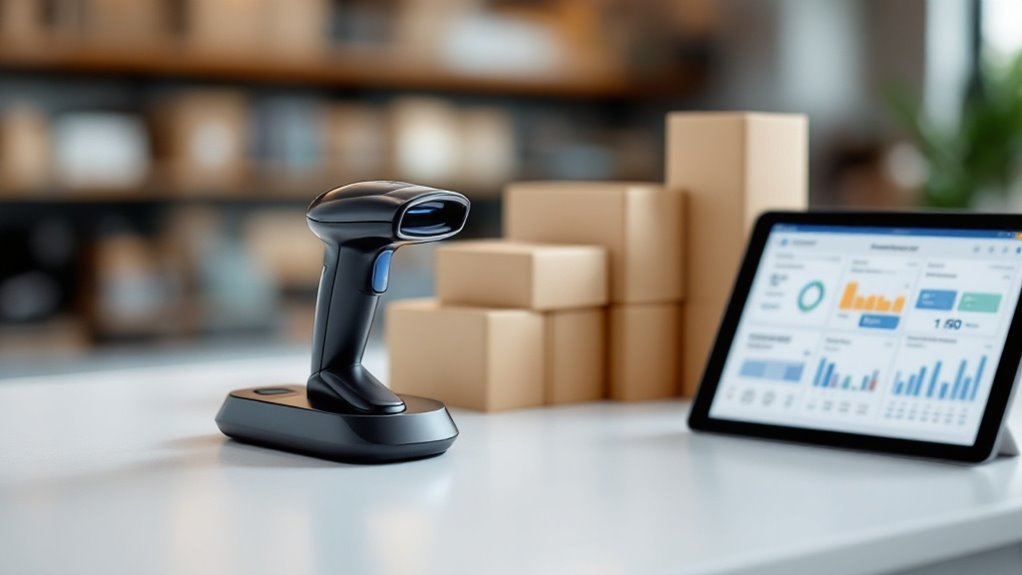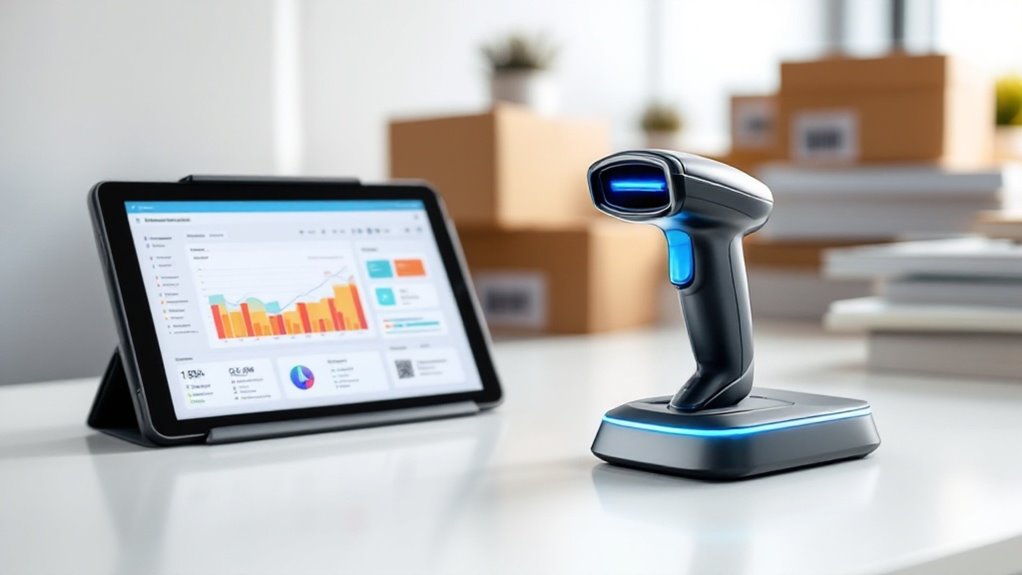Barcode scanning software helps small businesses automate inventory tracking and reduce costly errors. Modern systems combine scanning hardware with management software to process data efficiently. Key components include barcode labels (1D or 2D formats), scanning devices, and inventory software that work together to provide real-time stock visibility. The right system can improve accuracy, speed up operations, and cut labor costs. Understanding the essential components helps businesses choose an ideal solution for their needs.
Quick Overview
- Popular software options include Fishbowl and QuickBooks, which offer integrated barcode scanning capabilities for small business inventory management.
- Cloud-based barcode systems allow real-time inventory tracking across multiple locations while minimizing hardware and maintenance costs.
- Mobile scanning apps transform smartphones into barcode readers, providing a cost-effective solution for small businesses with limited budgets.
- Look for software that supports both 1D and 2D barcode formats to ensure compatibility with various product labeling systems.
- Choose software with customizable features like automatic reorder alerts, expiration date tracking, and detailed inventory reporting capabilities.
Understanding Essential Barcode System Components

Every successful barcode system relies on three core components working seamlessly together. These essential elements include barcode labels, scanning devices, and inventory management software that form the foundation of efficient inventory tracking.
Barcode labels come in two main formats: traditional 1D barcodes like UPC codes, and more advanced 2D versions such as QR codes that store additional data. The barcode scanner serves as the bridge between physical items and digital records, reading product information quickly and accurately.
Modern barcode formats bridge the physical and digital worlds, from simple UPC codes to data-rich QR symbols.
Modern inventory management software then processes this data, allowing businesses to create a barcode system that suits their needs.
When these components work in harmony, they create a streamlined barcode inventory management process that reduces errors, saves time, and provides real-time visibility into stock levels and product movements.
Top Benefits of Barcode Scanning Technology
Modern businesses recognize barcode scanning technology as a game-changing investment that delivers multiple strategic advantages. The integration of barcode scanning with inventory management software offers significant benefits that transform daily operations.
Key advantages include:
- Enhanced accuracy through automated data entry, virtually eliminating human errors in inventory tracking
- Improved operational efficiency with real-time tracking capabilities across multiple locations
- Faster customer checkout processes, reducing wait times and boosting satisfaction
- Significant cost savings from reduced labor needs and improved inventory control
- Prevention of stock shortages and overages through precise inventory monitoring
These benefits make barcode scanning systems particularly valuable for small businesses looking to streamline their operations and maintain competitive advantage.
The technology’s ability to automate routine tasks while improving accuracy makes it an essential tool for modern retail management.
Choosing the Right Scanner Hardware and Software

Selecting the right combination of barcode scanning hardware and software represents a critical decision for small business owners traversing the world of inventory management. When implementing a barcode system, businesses must first determine whether they’ll use 1D barcodes or QR codes, as this choice impacts scanner selection.
The scanner hardware must seamlessly integrate with inventory management software like Fishbowl or QuickBooks. Key factors to take into account include wireless connectivity options, scanning speed, and accuracy rates. Modern scanners with Bluetooth capability offer enhanced mobility, while multi-barcode scanning features boost productivity.
Smart business owners carefully evaluate the total investment, including maintenance costs and software licensing fees. This all-encompassing approach guarantees the chosen solution delivers long-term value while meeting current operational needs and future growth requirements.
Setting Up Your Small Business Barcode System
Once a business owner has chosen their hardware and software, establishing a functional barcode system requires careful planning and systematic implementation. The process begins with evaluating inventory needs and selecting appropriate barcode types that match the business requirements.
The next vital steps involve creating and managing barcode labels through reliable generator software, followed by establishing consistent print barcode procedures. Business owners must guarantee proper label placement and print quality for accurate scanning.
Training staff on scanning procedures is essential for smooth operations. Integration with inventory management software completes the setup process. By connecting barcode systems with platforms like Fishbowl or QuickBooks, businesses can maintain accurate inventory counts and streamline their operations.
This integration enables real-time tracking, reduces human error, and provides valuable data insights for better business decisions.
Best Practices for Barcode Inventory Management
Successful barcode inventory management hinges on establishing clear, systematic practices throughout a small business operation. Organizations must implement consistent protocols for scanning, data entry, and inventory updates to maximize system efficiency.
Clear protocols and systematic practices form the backbone of effective barcode inventory management, driving operational efficiency in small businesses.
Key practices include:
- Regular staff training on barcode scanning procedures and inventory management software
- Strategic placement of barcode labels for easy scanning access
- Systematic checks of product expiration dates using barcode tracking
- Integration of barcode data with existing business systems
- Regular audits to guarantee scanning accuracy
Small businesses should also establish backup procedures for system downtimes and maintain a standardized approach to barcode label generation.
Frequently Asked Questions
How to Set up a Barcode System for Small Business?
Setting up a barcode system requires five key steps.
First, evaluate inventory needs and choose between 1D or 2D barcodes based on business size and budget.
Next, use barcode generator software to create unique codes for each product.
Then, print and apply labels consistently across inventory.
Fourth, train staff on proper scanning procedures and system usage.
Finally, integrate the barcode system with existing inventory management software for streamlined operations.
What Is the Best Barcode Scanner Software?
Popular barcode scanner software options include Zoho Inventory, Scandit, and Asset Panda, each offering unique strengths.
Zoho Inventory excels in QuickBooks integration and real-time tracking, while Scandit provides superior mobile scanning capabilities.
Asset Panda stands out for its customizable features and user-friendly interface.
For ideal results, businesses should prioritize software that offers 1D/2D scanning support, cloud-based storage, and compatibility with existing point-of-sale systems.
How Much Does Barcode Software Cost?
Barcode software costs vary widely based on features and scale.
Basic options are often free, while paid plans typically range from $10-$50 monthly.
More extensive solutions with inventory management capabilities can cost $199-$1,000+ as a one-time purchase.
Enterprise-level systems may require substantial upfront investment plus annual fees.
Most providers offer tiered pricing based on user count or device numbers, with discounts available for annual commitments versus monthly payments.
Can Quickbooks Generate Barcodes?
Like a bridge needing supporting pillars, QuickBooks requires additional software to generate barcodes.
While QuickBooks itself cannot create barcodes natively, it works seamlessly with third-party barcode solutions.
Popular options include Fishbowl and various barcode printer applications that integrate with QuickBooks to create and manage barcodes for inventory items.
These complementary tools enable businesses to track products efficiently while maintaining synchronized inventory records within QuickBooks.
Conclusion
Barcode scanning technology has revolutionized inventory management for small businesses, much like how the abacus transformed ancient accounting practices. By implementing the right combination of hardware, software, and systematic processes, entrepreneurs can streamline operations, reduce errors, and boost profitability. Through careful planning and adherence to best practices, even the smallest companies can harness this powerful tool to compete effectively in today’s fast-paced marketplace.








